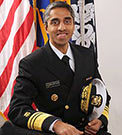|

 |
Columbus Dispatch
Use of
e-cigarettes by young people is major concern, surgeon general declares
By Matt Richtel
The New York Times
Friday December 9, 2016
Soaring use of e-cigarettes among young people “is now a major public
health concern,” according to a report published Thursday by the U.S.
surgeon general. It is the first comprehensive look on the subject from
the nation’s highest public-health authority, and it finds that
e-cigarettes are now the most commonly used tobacco product among
youths, surpassing tobacco cigarettes.
E-cigarettes, which turn nicotine into inhalable vapor, can harm
developing brains of teenagers who use them and also can create harmful
aerosol for people around the user, the equivalent of secondhand smoke,
the report said, citing studies in animals.
“Adolescent brains are particularly sensitive to nicotine’s effects”
and can experience “a constellation of nicotine-induced neural and
behavioral alterations,” the report said. It urged stronger action to
prevent young people from getting access to e-cigarettes.
Some researchers have said that e-cigarette use among youth could act
as a gateway to traditional smoking, but the report says the
relationship is not fully established. Cigarette smoking among youth
has fallen sharply in recent years, but use of nicotine products
overall remains essentially flat among young people.
With its focus on youth, the report did not address adult use of
e-cigarettes, and the most divisive issue of whether the technology is
an effective tool to help smokers of traditional cigarettes quit their
deadly habit. The report also did not break new scientific ground, but
public health advocates said the voice of the surgeon general in the
debate marked a milestone.
But there are still many questions that need to be answered when it
comes to e-cigarettes, and there is much division among the commercial,
public health and policy sectors, said Dr. Peter Shields, deputy
director of Ohio State University’s Comprehensive Cancer Center, where
researchers are studying the impact of e-cigarettes on lung health as
well as the effects of cancer-causing chemicals.
While the report says that e-cigarette use among adolescents and young
adults is rapidly increasing, there are different opinions over whether
that’s a bad thing, inconsequential or a benefit when it comes to
reducing tobacco use overall, Shields said. He advocates restricting
all tobacco products from young people.
“We’re in a major experiment right now, and that’s what really the
surgeon general’s report highlights, is we need to be thoughtful about
this,” Shields said. “I would love nothing more than a way to get kids
to stop smoking cigarettes and adults to quit — that’s what I’ve
dedicated my life to, so if this is it, great — but we have to figure
this out with solid research and not just speculation.”
In a preface to the report, the surgeon general, Dr. Vivek Murthy,
wrote that e-cigarette use among high school students increased “an
astounding 900 percent” from 2011 to 2015. Citing research from the
Centers for Disease Control and Prevention, the report found that 16
percent of high schoolers used e-cigarettes in 2015, up from 13.4
percent a year earlier. In 2015, nearly 38 percent of high schoolers
reported having tried an e-cigarette at least once.
Chief among the concerns raised by the report is simply that “nicotine
is a dangerous drug” to the developing brain, said Terry Pechacek, a
professor in the school of public health at Georgia State University.
It has been shown in animal models that nicotine damages the adolescent
brain, he said.
Echoing other research reports, the surgeon general’s report finds that
the $3.5 billion e-cigarette industry has mimicked marketing techniques
of the tobacco industry that they have “ found to be appealing to youth
and young adults.” Of particular concern has been the explosive growth
and marketing of flavored e-cigarettes; a study published last month in
the journal Pediatrics found that young people who smoked flavored
e-cigarettes were more at risk of taking up traditional smoking.
Dispatch Reporter JoAnne Viviano contributed to this story.
Read this and other articles at the Columbus Dispatch
|
|
|
|

